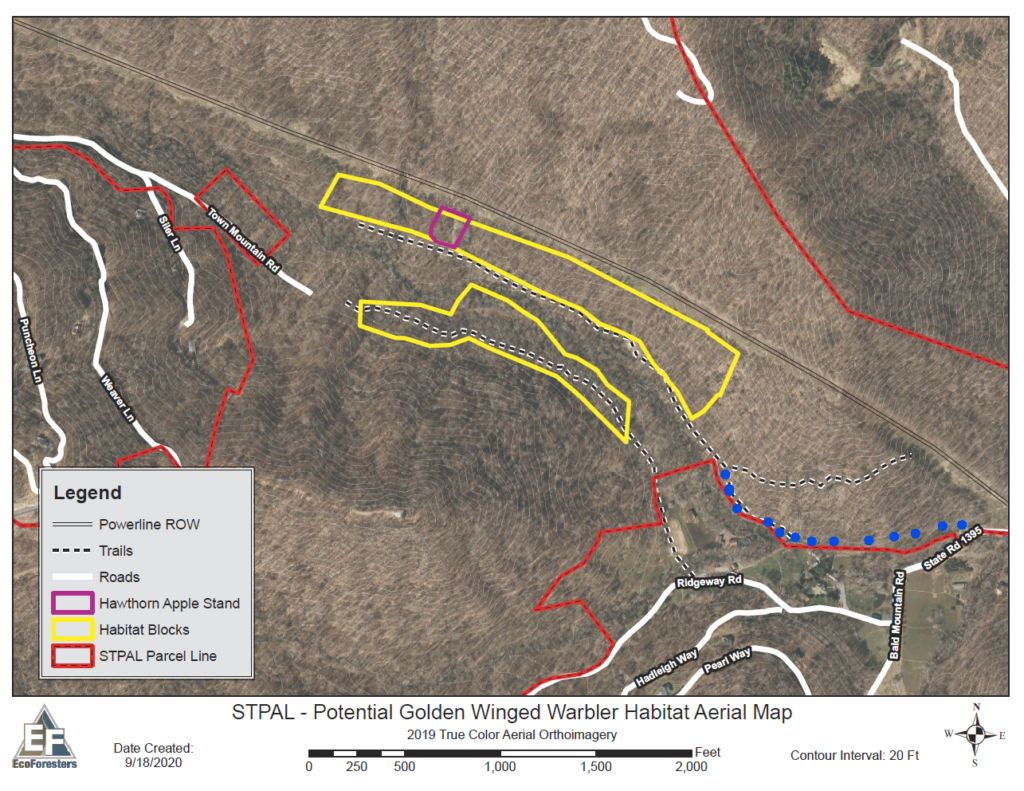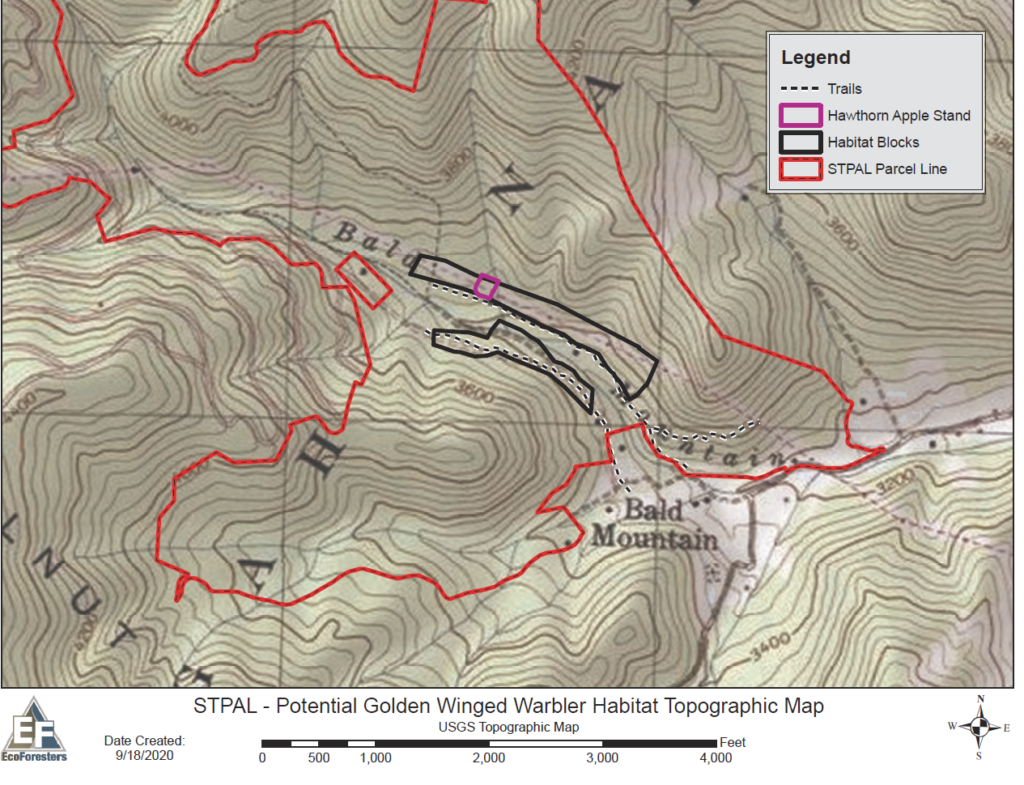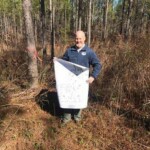Golden Winged Warbler Habitat Project Update
SE Trust Creates Much Needed Habitat for “Near Threatened” Golden-winged Warbler
Southeast Trust for Parks & Land (STPAL) and their Wildlife Consultant, Vic Vansant, is undertaking a project with Ecoforester, Carolina Audubon, USDA Equip program, and State of North Carolina Forestry and DENR to create 16-acres of habitat for the “near threatened” golden-winged warbler (GWWA) on 750-acres Bald Mountain Creek Nature Preserve in Yancey County, NC. This bird’s population has declined 98% in the Appalachians in the past 45 years, primarily due to habitat loss. However, one was heard at this site in 2014 by regional Audubon Conservation Biologist Aimee Tomcho, which lead to prioritizing this habitat expansion project, as GWWA often return to the same breeding sites year after year. The NC Wildlife Resources Commission’s (NCWRC) Technical Assistance Biologist Clint Barden helped advise and secure cost-share funding from the USDA Natural Resource Conservation Service (NRCS).
The neo-tropical GWWA winters in Central and South America and returns to the eastern US to breed every summer. For its breeding habitat, this bird relies on 5- to 25-acre patches of early successional habitat (ESH; i.e., young forests, meadows, and shrublands) with 10-15 large “perch” trees per acre, surrounded by mature deciduous forest. The existing power line on the property was providing some of this ESH for the GWWA but expanding this by creating more adjacent young forests in a more natural shape and size for the bird was key.
EcoForesters’ forest restoration crew established the initial 2-acre young forest habitat block this year by felling many of the common dense trees near the powerline with little to no economic value and applying herbicide to stumps to prevent these trees from resprouting to maintain the habitat for the GWWA for a longer period of time. An additional 14-acres of the adjacent more mature forest will be harvested by a logger to create more habitat and help fund the project. EcoForesters also controlled all the non-native invasive plants on the site so that they will not overtake the newly created growing space. This is an essential step before any planned forest disturbance.
ESH is an underrepresented habitat type across our forested landscapes. It is estimated that 100+ years ago 5-10% of forests used to be maintained in this early successional state through native grazing (elk, bison), fire, wind, ice, and natural tree mortality. However, since around 1900 native grazers have been extirpated, fire has been suppressed, and widespread clearcuts have regenerated into an even age forest without much structural diversity, which benefits many declining species of wildlife, not just the iconic, near threatened golden-winged warbler.
The primary goal of the project is to create a habitat for this at-risk bird species. Therefore, timber harvesting will need to be done by very skilled loggers. Other advantages to the timber harvest are to improve the many poorly designed and eroding old logging roads on the property, to protect water quality in the nearby trout stream, and to establish better access to this permanently conserved nature preserve to allow for public hiking and maintaining the habitat for the bird. Without regular disturbance (controlled burning, cutting, grazing, or applying herbicide) the habitat will grow up and no longer be suitable for the GWWA.
All wildlife-friendly trees – oaks, in particular, but also cherry, hickory, beech, hawthorns, apples, witch hazel, and standing dead trees – were left to increase the value of the ESH for all associated wildlife species. The vast majority of the trees marked for harvest are the very common yellow-poplars. Smaller trees were also left scattered or in clumps to create more habitat diversity. And of course, no harvesting can happen during the breeding season for all birds (April-July). Furthermore, a proposed stream crossing was avoided and stream buffers of at least 50’ were left untouched to ensure high water quality was maintained and to break up the ESH for more edge habitat which is especially important to all wildlife.
Aimee Tomcho reported the following on April 25, 2021: I enjoyed visiting the GWWA restoration site Friday afternoon. There were a bunch of songbirds using the restoration area already (Blue-headed vireo, Black-throated green warbler, Hooded warbler, Black-and-white warbler…)! GWWAs are not back yet but I will go up there in a few weeks and conduct surveys. Lots of Fringed Phacelia blooming along the forest road.
The U.S. Fish & Wildlife Service, the American Bird Conservancy, Appalachian Mountains Joint Venture, Audubon North Carolina, Fundacion Proaves-Colombia, numerous universities & states’ wildlife departments, as well as private foundations are collaborating to help restore this species by aiming to double its population in the Appalachians in 40 years.
More About The Golden Winged Warbler


